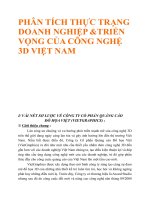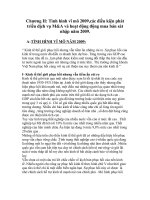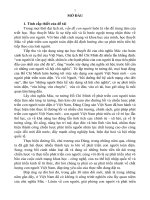VIetnam World Macro Short Outlook (Foreign Publication) Triển vọng Tình hình Vĩ mô Việt Nam Thế giới Tóm tắt 2018
Bạn đang xem bản rút gọn của tài liệu. Xem và tải ngay bản đầy đủ của tài liệu tại đây (217.64 KB, 2 trang )
MACRO OUTLOOK
MARCH, 3RD 2018
I.
MACRO ONE-YEAR OUTLOOK AND EXPECTATION: WORSEN
1)
US MACRO – ECONOMY MAY GO UNDER STAGFLATION & RECESSION AS OF OVERHEATING ECONOMY
* Inflation soaring back, first sign revealed, next would be a surprise –It start with February report of higher than
expected wage pay (+2.9% MoM) – highest increase since 2009 that triggered the sell off in the stock market on Feb 2nd .
Then the CPI report came out, with worse than expected: 0.5% MoM (forecast: 0.2%) and CPI YoY reach 2.1% (forecast:
1.9%), highest since 1 year. This question the expectation for continous growth of the U.S economy and the stability of
the goods market in the following year.
* FED may raise rates faster than expected – Three years since 2015, Fed has raised the interest rate 5 times and is
starting to pick up the pace in 2017 with 3 times rate hike, increase the FED Fund Rate up to 1.5%. Recently, US investor
concern about inflation shows sign of trending up and the economy is over-heating which may make the FED increase
rate up to 4 times. Although FED’s Chairman Jerome Powell still provide no clear sign about their decision, I believe that
4 times would be his appropriate strategy with above prediction that inflation would push even further than forecast
which will be showed on March CPI report.
* Oil price rapid increase would put big pressure on the economy – Oil price has surged up to 50% in just half –
year of 2017 with tension in OPEC countries & their agreement with Russia to maintain low oil supply. In the future
market, WTI Crude Oil Futures recently peaked at $66.14/barrell (+ 54.75% from one-year lowest point) while Brent Oil
Futures peaked at $70.52/barrell (+ 57.34% from one-year lowest point). I predict that the oil market would further
bullish as of extend in oil supply cut between OPEC and Russia in 2018, a lower-than-expected U.S supply and the launch
of China’s Oil Futures on March 26th. The cost of manufacturing will significantly rise in first two quarters of this year.
* Anti trade deficit policy and the trade war may cause more harm than benefit - Since Trump administration
of the White House, U.S has applied “close-border poicy” which to reduce trade deficit, increase internal employment,
support domestic businesses. In only over a year, U.S has withdrawn from many international agreement including TPP,
Paris, UNESCO, etc. , impose significant tariff on China’s & many countries goods and is about to withdrawn from many
other free-trade agreement including NAFTA, WTO, etc. Also since 2017, the “weak dollar effect” has further strengthen
the anti-deficit policy and caused the U.S Dollar to lost value significantly (13% since its 16-years high of 102.29 and now
trading at 89.95). Normaly it would be a good thing, but since U.S has long been country who selling ideas and
management rather than a manufacturer, U.S goods price may stir-up dramatically along with the cost of manufacturing,
which would drag slower economy and high inflation (stagflation – which is even danger).
* Debt balance reach record high, lending still ease – In 2017, U.S bank industry witness total debt balance reach
record high - highest since 2008 with total non-housing debt of $3.76 trillion and housing debt of $9.19 trillion. Credit
card debt at highest level in the world with $0.81 trillion. Auto-loan debt is the worst, set a 6 year continous uptrend
with 23 millions people buying under subprime mortage (aacount for 20% of new buying). Student loan, also have huge
accumulation in total debt, The situation raise an alarm for an alike 2008 financial crisis seranio which is not noticed by
much people. Bank lending still ease, with prime lending rate only increase 1.2%, while FED fund rate has up to 1.5% till
recently, which could further worsen the debt situation.
* Income tax reduce, things get more unstable: The U.S government officially announced to cut income tax in 2018 –
2020 period. Specifically, income level remain unchange but income tax rate has decreased from 3 – 4 percent at each
income level, This create problem in the macro system as it weaken the automatic stabilizer and create advance risk of
uncontrollable fiscal & monetary policy effect especially under significant change from Trump administration (tax bill
change, massive government spending, tighten monetary, reconstruct & infrastructure upgrade, etc.). Yet this maybe
seen affect later as due to policy lag which is about 4 – 6 months.
2)
VIETNAM MACRO – MAJOR SUPPORTS WOULD BE AFFECTED, SIGNIFICANT GROWTH WOULD EASE
* FDI may retreat as raising fear of FED rate hike - In 2017, FDI reach record high in 9 years with newly registed FDI of
$35.88 billions & FDI Disbursement reach $17.5 billions. There are 115 countries and regions investing in Vietnam, with
Japan in the first place, Korea is in the second and Singapore is in third place. With FED fund rate hike faster than
expected, the U.S Dollar may turnover to appreciate largely against the Vietnam Dong. However, under Vietnam
government regulation & foreign currency reserve, my forecast of USD/VND exchange rate in the next 6 months would
rise slower to 23.000 (+ 1.3 -1.7% from current rate) – which still remain high volatility. Foreign loan for FDI are
becoming more expensive and the foreign bond yield is catching up quickly with the return on stock market (specifically
2.88% in 10 year U.S, 2.77% in 10-year South Korea and 4.02% in 10-year Vietnam).
* Trade war continue, countries closing border for Vietnam – As many big market seeking to close free trade and raise
tariff like U.S, Vietnam’s firm suffer significant lost in market shares. Metal & agriculture are among most affected
indutries with this chang. Currently, steel & aluminium product export from Vietnam are suffering 40 -120% taxes while
agriculture (fish, lobster) carry 2 – 4 extra dollar per kilograms tariff and plus average 2% taxes. This make export
product difficult to gain market shares in the thirst for demand. In the domestic market, the consumer behaviour still
remain highly porpotion of savings (66% income – Nielsen Research) and compulsory consumption while focus only
small to medium percentage for shopping externality and ultilities (30 – 44 %). With the Golden Age came to an end,
the domestic may not provide enough further incentive for firms to continously grow in near future.
* Goverment debt may breach ceiling, new funds tighten – At the end of 2017, gorvenment debt reach 3,100 trillion
Vietnam Dong, account for 62.6% GDP, only 2.4% lower than the debt celling. Debt/citizen in Vietnam reach 33 million
Vietnam Dong, 7 times of workers salaries and 3 times of average white collar wage. With the tightened new funds from
World Bank and Asian Development Bank, Vietnam may no longer recieve discounted loans and would suffer heavy
borrowing cost which triggered the bad scenario.
II.
INVESTMENT THESIS: STAY LOW ON PORTFOLIO
1)
PORTFOLIO REBALANCING & SEARCHING FOR DEFENSIVE STOCK
In the current situation, the macro outlook is getting worsen and risk are increasing in the equity market. Therefore we
should rebalancing the portfolio with a portion of equity under 30%. Holding cash is best for this situation for
opportunity to join in after correction but goverment bonds or bank deposit could be appropiate for large portfolio. In
the 30% of equity, focusing more on defensive stock with low P/E . I recommend stocks of medical equipments,
consumer compulsory (clothes, daily consumed food) and electricity. The fact that they have gone unoticed for a long
time has make their price attractive and risk-less that are appropiated to consider.
2)
HEDGING USING DERITATIVE
The suitable length for deritative contract is 4 -8 months from now, which is when we predict the economy to suffer
from recession. Contract VN30F1806 and VN30F1809 with 20% portfolio will help reduce unfavourable movement and
create chance to outperform the general market.

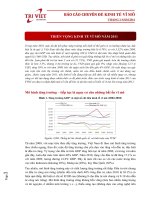
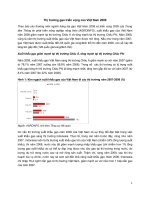

![[Luận văn]đánh giá đặc điểm nông sinh học của một số dòng ngô thuần và một số tổ hợp lai triển vọng tại CHDCND lào và việt nam](https://media.store123doc.com/images/document/13/gu/oh/medium_xwWNWraJjU.jpg)
